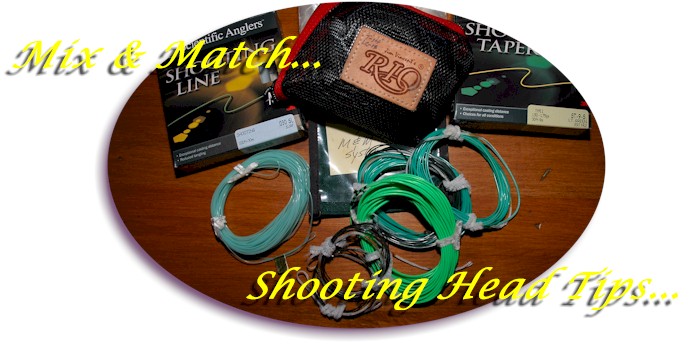Shooting Heads – The Mix and Match Tip System
By Dan Blanton
Shooting heads of varying sink rates packaged in a compact line wallet have long, provided knowledgeable fly anglers tremendous versatility. Using shooting heads (SH), the feeding zone can easily be explored with flies of all persuasion, from the surface to depths exceeding 50 feet or more, casting long or short. Anything can be improved upon, however, and as good as the SH system is, many years ago myself and a few other experienced California/Oregon steelheaders and salt-chuckers, took it even further by mixing and matching the ten-foot tip sections of standard 30-foot heads, providing even more versatility, while simultaneously simplifying the system.
When the first sinking fly lines, including heads, were made available, it didn’t take observant fly fishermen long to figure out that the tapered, leader end of the line didn’t sink as fast as the belly section did. This was because the tapered end lacked the same mass and density as the belly or body of the line. In fishing terms this simply meant that the tip section along with leader and fly would be higher in the water column than the belly, often completely missing the strike or feeding zone, or only fishing there briefly. We knew a sinking line which had a tip section that would sink as fast as the belly, would markedly improve success, and after much urging, Scientific Anglers (and others now) produced and has since marketed the “Uniform Sink Rate”, in both shooting heads and full-length, sinking lines – a line with a tip section that sinks at the same rate as the belly section. Good but not good enough…
Even before S.A. produced the Uniform Sink Rate, experienced devotees of sinking heads, particularly salmon and steelheaders, knew that there were many times when a SH with a tip section which sank faster, sometimes several times faster, than the belly was the answer to consistent success. Accordingly, many of us long ago, started mixing and matching shooting head tip sections, producing our own vary-tip sinking and floating lines. Some North coast steelheaders made their own sink-tip heads; and many of California’s fall salmon and winter-run steelheaders produced their own uniform sink rate shooting heads and multi-density lines, often splicing two or three different densities together to produce a head that would contour the bottom, keeping the fly moving through the strike zone without the belly of the line fouling on rocks or dragging on the lip of a bar.
Early on, most of us permanently spliced our lines together using the “Russ Peak” sewn splice, or whip-served the junction. Today, however, most are using an inter-locking looping system that permits tip sections to be interchanged. The system most of us now use is simple, expedient, and extremely effective and can be assembled by anyone with only a few basic materials, dexterity, and minimal time. This mix-and-match tip system has reduced the thickness of my old shooting head wallet a couple of inches by eliminating several permanently spliced dual-density heads without sacrificing my ability to cover the water like a tent.
The secrete of the system is to incorporate a quick-change tip section utilizing the “Double-catch braided mono loop”, today’s most popular method of forming a connecting loop on a fly line. For detailed instructions on how to make a double catch, braided loop go to the article Getting Looped on the Tackle and Techniques page. Here’s how you’d put a mix-and-match shooting head system together.
Lets start off with the full course of commercially available 30-foot shooting heads (although you may choose to have fewer lines), a total of five densities (not counting Deepwater Express, lead cores or similar lines) for any given rod weight, being sure that the lines are at least two weights heavier than the rod rating for better rod loading and fly delivery. These include: a floater; an intermediate type I, a type II, fast sinker; a type III and a type IV.
Now, cut off the first ten feet of the tapered end of each line. This leaves you with five, ten-foot tip sections and five 20-foot bellies (a short, 20-foot shooting head). You’ll need a total of 20 braided monofilament loops unless you purchase heads with factory welded loops. You can purchase braided loops but it is best to make your own. Each ten-foot tip section will take two loops, as will the 20-foot belly sections – loops made from 50-pound test braided mono. The braided loops are placed on the line sections using the “Inch Worm” method, running the line inside the core of the braided mono until it touches the base of the loop splice. The loop is best secured to the line with a 10-pound-test, “trap” Nail knot, avoiding heat shrink tubes and instant glues, which will fail. The Nail knot does not singularly secure the loop to the line. Most of the gripping comes via the old Chinese finger lock principle: the tighter you pull on the loop, the tighter the braid grips the line. Coat only the Nail knot with Plyobond, or other good flexible cement, not the entire braided sleeve. Doing so will negate the gripping capabilities of the braid. Again, most of today’s shooting heads come with welded loops which are superb. These will save you having to install a braided loop at the leader and shooting line ends of the heads and tips.
As for the two loops on the tip sections, one is for looping on a leader or a butt section and the other is for looping it to a 20-foot head. Likewise, one loop on the 20-foot head is for receiving a tip section and the other is for connecting the shooting line of your choice, usually with a similar loop on level, coated, shooting lines, or a Surgeon’s loop or Clinch knot when using mono shooting line.
Now that you have loops on all of the 10-foot tips and 20-foot bellies, it’s a simple matter to mix and match tips to meet any condition. For example: you could have a floating sink-tip with four different density tips, each sinking progressively faster; an I-line (one of my favorites) a type II, a III and so on. I take it even further, though, by making several tips of T-14 and T-8. These super sinking tips can be made in any length, even mini-tips of less than five feet but I usually fish them in three lengths: a 5-footer, a 10-footer and one 15 feet long. These tungsten tips greatly add to the versatility of the mix-and-match tip system. Of course you may re-join original lines, matching the tip to the belly, if a faster sinking tip is not required.
One of my absolutely favorite heads for deep-water lake fishing, fast, deep rivers or subsurface saltwater (stripers, blues, channel tarpon, etc.) is a 20-foot type IV with a ten-foot T-14 tip. It casts like a dream, and the T-14 tip turns over big flies like they are fitted with a jet engine after-burner. This line configuration, an 11-weight for my 9-weight, is perfect for California Delta striper fishing in areas ranging in depth from 6 to 10 feet; and it also proved highly successful for many East coast striper fisheries. Lefty Kreh says it is the best shooting head he has ever tossed.
I’ve written about and have promoted the use of shooting heads for more than three decades, converting hundreds into the faith. Still, there are those who still prefer to use a full-length sinking line or Teeny-type sinkers, which are full-length lines that cast like a head but obviously can’t provide quick-change versatility – or can they? Indeed, you can mix-and-match tips (including the use of lead-core and tungsten tips) on these line-types using the same splicing techniques, increasing your line range and versatility – although they will never match the adaptability of a shooting head system…
What about other obvious concerns: Does the tip-section hinge at the loop? Not by any appreciable amount. Does the mono loop splice pass easily and quietly through the guides without hanging up? No splice passes through guides without making some noise. The looped splices are as quiet as any (I’ve always maintained that if you are bothered by the slight ticking of a splice shooting through the guides, cut back on the caffeine!), and, if made properly, they will never hang up in the guides.
The beauty of the mix-and-match tip system is that you can start off with just a couple of heads and build up the system as needed. Often, however, you’ll realize that you only need one or two heads for all the fishing you do in a particular area; or, you may find that after building a mix-and-match system, one basic head, say a type II, fast sinker, utilizing various tips will let you effectively work a variety of waters, flies and depths. One good example of this is when I fished the Dean River in B.C. a few years ago. When not dry-fly fishing or greased-lining (the later of which I rarely ever do), I was able to effectively cover all the water in every pool with a wet fly, on the entire Hodson’s Lodge beat, using a 20-foot, 9-weight, type II, fast sinking head, by mixing-and-matching tips, including utilizing lead-core tips. On some shallow, narrow and rocky runs, I resorted to using only the 20-foot head without a tip in order to get a clean, snag-free drift. I could have reached into my line wallet for a lesser density head and tip, but I didn’t need to – which is the beauty of this entire system – versatility you never dreamed off – from panfish to billfish.

